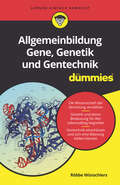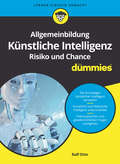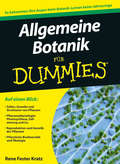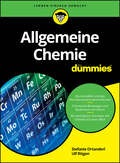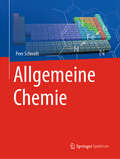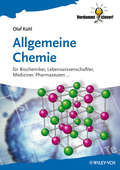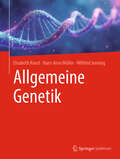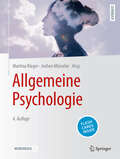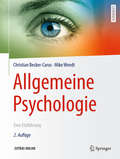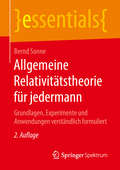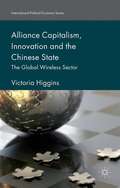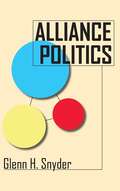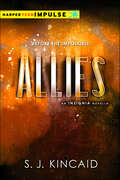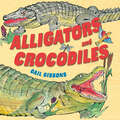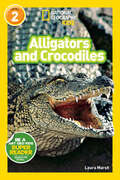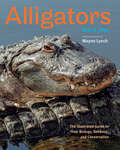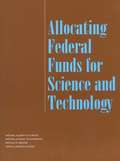- Table View
- List View
Allgemeinbildung Gene, Genetik und Gentechnik für Dummies (Für Dummies)
by Röbbe WünschiersWie weit darf oder muss der Einsatz von Gentechnik gehen? Angesichts von Klimakrisen und dem Rückgang der biologischen Vielfalt müssen wir differenzierter auf neue Techniken schauen. Viele sagen, dass dies die Aufgabe der Experten sei, doch mit der Entdeckung der Genschere CRISPR/Cas rückt die Gentechnik in den Entscheidungsalltag eines jeden Einzelnen. Diagnostik, Kinderwunsch, Gentherapie? Innerhalb des gesetzlichen Rahmens muss diese Entscheidungen jeder selbst treffen. Röbbe Wünschiers bietet Ihnen mit seinem Buch "Allgemeinbildung Gene, Genetik und Gentechnik für Dummies" eine neutrale Einführung in die Gentechnik und deren Bedeutung für Ihren Lebensalltag. Die Debatte um die Anwendung der Gentechnik spaltet die Gesellschaft, doch die Wichtigkeit dieser Debatte ist unumgänglich. Lernen Sie mehr über dieses spannende Thema und bilden Sie sich eine eigene Meinung.
Allgemeinbildung Künstliche Intelligenz. Risiko und Chance für Dummies (Für Dummies)
by Ralf OtteSie haben schon oft von Künstlicher Intelligenz gelesen, finden das Thema spannend und wollen mehr darüber erfahren? Dann ist dieses Buch genau das richtige für Sie. Extra für Laien geschrieben erklärt Ihnen Professor Ralf Otte, was es mit Künstlicher Intelligenz auf sich hat. Er erläutert systematisch und allgemein verständlich die technischen Grundlagen und geht auf aktuelle Anwendungen und neue Möglichkeiten in der Zukunft ein. Zudem führt er Sie in wichtige gesellschaftliche und philosophische Fragen ein, die die Künstliche Intelligenz mittlerweile aufwirft.
Allgemeine Botanik für Dummies (Für Dummies)
by Rene Fester KratzVon der Wurzel bis zum Blatt – alles, was die Botanik zu bieten hat Ohne Pflanzen wäre das Leben des Menschen auf der Erde undenkbar – sie dienen als Nahrung, Sauerstoffund Energielieferant, Baustoff und Heilmittel. Dieses Buch gibt Ihnen einen umfassenden und leicht verständ - lichen Überblick über die Botanik, von den zellbiologischen Grundlagen über die verschiedenen Pflanzen - gewebe und -strukturen bis hin zu Physiologie, Genetik, Systematik und Ökologie. Themen wie Biodiversität, Biotechnologie und die Bedeutung von Pflanzen für den Menschen runden das Buch ab. So ist Allgemeine Botanik für Dummies das Richtige für Sie – egal ob Sie studieren oder sich einfach für Botanik interessieren.
Allgemeine Chemie - ein Leselehrbuch
by Georg SchwedtDas Buch soll das Chemiewissen vermitteln, das nach #65533;berzeugung des Autors zur Allgemeinbildung geh#65533;rt. Dazu bedient es sich in erster Linie der Sprache, die - wo n#65533;tig - durch chemische Formeln und Gleichungen erg#65533;nzt wird. Auf diese Weise schl#65533;gt das Buch eine Br#65533;cke zwischen der Schulbildung und universit#65533;rer Lehre, so dass es eine Empfehlung f#65533;r Studierende aller Fachrichtungen ist, die ihre erste Chemie-Vorlesung h#65533;ren. Sch#65533;ler, Lehrer und interessierte Laien k#65533;nnen ihr Chemiewissen ebenfalls auffrischen und erweitern.
Allgemeine Chemie für Dummies (Für Dummies)
by Stefanie Ortanderl Ulf RitgenSystematisch und mit vielen Übungen Chemie lernen Die Chemie ist in zahlreiche Teilgebiete gegliedert, doch gewisse Grundlagen braucht jeder Chemiker, denn nur auf einem guten Fundament lässt sich komplexeres Wissen aufbauen. Stefanie Ortanderl und Ulf Ritgen erklären Ihnen in diesem Buch verständlich, aber detailliert und mit vielen Beispielen die nötigen Basics. Von chemischen Bindungen über Stöchiometrie und Nomenklatur bis Komplexchemie ist alles dabei – und noch viel mehr. So ist dieses Buch die perfekte Vorbereitung auf die höheren Fachsemester und die nächste Klausur kann kommen. Sie erfahren Was es über Materie, Normen und Energie zu wissen gibt Was das Periodensystem der Elemente im Detail ausmacht Was es mit Gasen, Flüssigkeiten und Feststoffen auf sich hat
Allgemeine Chemie: Chemische Bindung Ii
by Peer SchmidtDas Arbeitsbuch führt durch das erfolgreiche Lehrbuch der Allgemeinen und Anorganischen Chemie von Binnewies et al. und ist explizit für das Selbststudium konzipiert.
Allgemeine Chemie: für Biochemiker Lebenswissenschaftler, Mediziner, Pharmazeuten... (Verdammt clever!)
by Olaf KühlKompakt und »verdammt clever« auf den Punkt gebracht - so gelingt mit diesem klar strukturierten Lehrbuch der optimale Einstieg in die Grundlagen der Chemie. Nicht nur für angehende Chemiker, Biochemiker und Chemieingenieure, sondern auch für alle Studierenden der Lebenswissenschaften, Medizin und Pharmazie ist die allgemeine Chemie Voraussetzung für das Verstehen von Sachverhalten benachbarter wissenschaftlicher Disziplinen. Mit dem Blick aufs Wesentliche gerichtet, sind alle prüfungsrelevanten Lerninhalte wie der Aufbau des Periodensystems, Bindungskonzepte, Säure-Base und Redoxreaktionen und vieles mehr äußerst verständlich erklärt und abgedeckt. Dabei unterstützen besondere Textelemente Ihren Lernerfolg: * Für inhaltliche Orientierung sorgen optisch hervorgehobene Schlüsselthemen am Kapitelanfang. * Das Wichtigste wird kurz und prägnant in Definitionen und Merksätzen zusammengefasst. * Beispiele helfen beim Anwenden des Lernstoffs. * Ideale Hilfe beim Nachschlagen von relevanten Stichworten und Begriffen bietet ein Glossar. * Wissenstest und Prüfungsvorbereitung: Aufgaben mit Lösungen helfen ungemein beim eigenständigen Überprüfen des Gelernten.
Allgemeine Genetik
by Elisabeth Knust Hans-Arno Müller Wilfried JanningEntdecken Sie die faszinierende Welt der Genetik mit unserem neuen Lehrbuch “Allgemeine Genetik”! Dieses kompakte und verständliche Werk ist speziell für Studierende konzipiert und bietet eine umfassende Einführung in die Grundlagen der Genetik. Tauchen Sie ein in die Mechanismen, die die Weitergabe von Merkmalen und Eigenschaften von Generation zu Generation kontrollieren. Darüber hinaus werden die molekularen Prozesse beschrieben, die zur regulären Funktion der Gene führen. Lesen Sie über die Prozesse der Meiose und Zellteilung, und verstehen Sie die Mechanismen der Translation. Erfahren Sie mehr über die Humangenetik und das menschliche Genom, und entdecken Sie die Geheimnisse des Zellzyklus und der Epigenetik. Lernen Sie, wie Mutationen entstehen und wie Genkartierung funktioniert. Verfolgen Sie den spannenden Weg vom Genom zum Phänotyp und vieles mehr. Unser Lehrbuch ist reich an anschaulichen Abbildungen, die komplexe Konzepte visuell verständlich machen und das Lernen erleichtern. Tabellen und Infoboxen ergänzen den Text und unterstützen den Wissenserwerb. “Allgemeine Genetik” ist das ideale Werk für Studierende, die eine solide Grundlage in der Genetik erwerben möchten.
Allgemeine Histologie: Ein Kursbegleiter für Humanbiologen mit Atlasteil
by Hans-Peter ElsässerDieses Lehrbuch bietet eine kompakte Einführung in die allgemeine Histologie der Vertebraten, wie sie in einem einsemestrigen Kurs vermittelt wird. Kapitel zu den Grundgeweben (Epithelien, Binde- und Stützgewebe, Muskelgewebe und Nervengewebe) werden ergänzt durch die Themen Zellteilung sowie Blut und Gefäße. Jedes Kapitel enthält eine Anleitung zum Mikroskopieren mit einem Atlasteil, der Präparate zeigt, wie sie in gängigen histologischen Kursen verwendet werden. Hinweise zu den Färbungen und zur Handhabung eines Mikroskops unterstützen die praktische Arbeit im Kurs. Zur Prüfungsvorbereitung stehen umfangreiche Fragenkataloge zur Verfügung. Dieses Buch eignet sich besonders für Studierende der Biologie, Humanbiologie und deren Grenzfächer.
Allgemeine Psychologie
by Jochen Müsseler Martina RiegerDie Neuauflage dieses Standardlehrbuchs bietet einen umfassenden Einblick in zentrale Aspekte menschlichen Erlebens und Verhaltens. Hierbei stehen Prozesse und Mechanismen der psychischen Vorgänge im Vordergrund, welche aus kognitions- und neurowissenschaftlicher Perspektive betrachtet werden. Inhaltlich werden in diesem Standardwerk folgende wesentliche Themenbereiche dargestellt: Wahrnehmung und Aufmerksamkeit; Emotion und Motivation; Lernen und Gedächtnis; Sprachproduktion und -verstehen; Denken und Problemlösen; Handlungsplanung und -ausführung. Die einzelnen Kapitel wurden von Expert:innen des jeweiligen Gebiets verfasst. Diese vierte Auflage ist grundlegend aktualisiert und durch zusätzliche Kapitel ergänzt worden. Die Inhalte werden durch konkrete Anwendungsbeispiele – aus der Forschung für die Praxis – und informative farbige Illustrationen sowie ein didaktisch ausgereiftes Layout veranschaulicht. Zusätzlich sind sie mit digitalen Fragen und Antworten zum Selbsttest angereichert. Wie die vorhergehenden Auflagen bietet auch diese Auflage eine kompetente Einführung für Studierende, die ideal ist zur Prüfungsvorbereitung im Bachelor- und Masterstudium. Gleichzeitig ist dieses Werk ein optimales Nachschlagewerk für wissenschaftlich und praktisch arbeitende Psycholog:innen und Personen aus benachbarten Disziplinen. Studierende und Dozierende finden hilfreiche Online-Zusatzmaterialien und die inkludierte Flashcard-App auf der Begleitwebseite.
Allgemeine Psychologie: Eine Einführung (Spektrum Lehrbuch Ser.)
by Christian Becker-Carus Mike WendtDieses klassische Lehrbuch zur Einf#65533;hrung in die grundlegenden Themen der Allgemeinen Psychologie (I und II) ist zugleich ein vorz#65533;gliches Werk zum Nachschlagen und zur Wissensvertiefung. Es richtet sich vornehmlich an Studierende und ist bestens geeignet zur Pr#65533;fungsvorbereitung im Bachelor- und Masterstudiengang. Dar#65533;ber hinaus fasziniert das Buch mit seiner klaren Strukturierung, Bebilderung und leichten Lesbarkeit auch Studierende der Nachbardisziplinen sowie alle an dieser Thematik Interessierte. Sie erfahren grundlegende Zusammenh#65533;nge und psychologisch biologische Hintergr#65533;nde, die Ihnen im Beruf und bei diversen Herausforderungen im Alltag hilfreich sein k#65533;nnen. Sie lernen die g#65533;ngigen Theorien und Befunde des gesamten Spektrums menschlicher Informationsverarbeitung und -Interaktion kennen, von der Aufnahme von Reizinformationen in den Sinnesorganen #65533;ber Lern-, Ged#65533;chtnis- und Denkprozesse bis hin zum emotionalen Empfinden und der Steuerung von Handlungen, aber auch die Bedeutung und Funktion von Bewusstseins- und Schlafprozessen sowie die genetischer Festlegungen. Zus#65533;tzlich wird in einem besonderen Abschnitt ein kurzer Einstieg in die generellen statistischen Datenerhebungs- und Auswertungsverfahren geboten. Die anschauliche Darstellung der einzelnen Inhalte wird weiterhin gew#65533;hrleistet durch: #65533; Ankn#65533;pfungen an alltagspraktische Beispiele #65533; Kritischen Reflexionen Diverse didaktische Elemente machen dieses Buch zur gewinnbringenden Lekt#65533;re und zur erfolgversprechenden Pr#65533;fungsvorbereitung mit: #65533; Auflockerungen durch originelle Untersuchungen #65533; Anleitungen zu kleinen Demonstrationsversuchen #65533; Verst#65533;ndnisfragen und Zusatzmaterialien #65533;ber www. lehrbuch-psychologie. de Dadurch regt das Werk auch zum Mit- und Weiterdenken an, in dem auch Lehrende wertvolle Impulse und Materialien finden k#65533;nnen.
Allgemeine Relativitätstheorie Schritt für Schritt: Eine Einführung mit Details, Beispielen und Aufgaben
by Michael RuhrländerDas vorliegende Buch bietet Studierenden der Physik eine übersichtliche Einführung in die Allgemeine Relativitätstheorie: Was ist der Energie-Impuls-Tensor und was beschreiben die Friedmann-Gleichungen? Wie kann man die Raumzeit durch eine Mannigfaltigkeit modellieren? Was ist die Schwarzschild-Lösung und wann benötigt man Kruskal-Koordinaten? Kann man Energie aus der Ergosphäre eines rotierenden Schwarzen Loches gewinnen? Diese Fragen und viele mehr werden in diesem Buch beantwortet. Der didaktische Fokus liegt auf einer einfachen und verständlichen Vermittlung und detaillierten Darstellung des komplexen Themas. Das Buch verzichtet bewusst auf Phrasen wie „es kann gezeigt werden, dass..“ oder „wie man leicht zeigt, gilt“ und zeigt die Rechenschritte in Aufgaben und Herleitungen ausführlich auf. Zur Wiederholung werden die wesentlichen Punkte aus der Lagrange’schen Mechanik, der Elektrodynamik und der Speziellen Relativitätstheorie kurz dargestellt. Mathematische Vorkenntnisse sollten Leser v. a. im Bereich der Linearen Algebra und der komplexen Zahlen mitbringen, notwendige weiterführende Mathematik wie Differenzialgeometrie wird sorgfältig, zweckmäßig und verständlich eingeführt. Konkrete Aufgaben mit vollständigen, ausführlichen Lösungen laden zum Mitdenken und Mitrechnen ein. Das Buch ist in fünf Teile gegliedert: - Grundlagen der Speziellen Relativitätstheorie und Folgerungen für die relativistische Mechanik und Elektrodynamik - Wichtige Ergebnisse des Newton’schen Gravitationsmodells und Notwendigkeit einer neuen Gravitationstheorie, Modellierung der Raumzeit durch eine Lorentz-Mannigfaltigkeit - Physikalischer Schwerpunkt: heuristische und formale Herleitung der Einstein-Gleichungen - Astrophysikalische Objekte: Herleitung der Schwarzschild-Metrik, das Innere eines Sterns, nicht rotierende, rotierende und geladene Schwarze Löcher, Eddington-Finkelstein- bzw. Kruskal-Koordinaten, Penrose-Diagramme - Anwendung auf unser Universum: Homogenität und Isotropie des Universums, Robertson-Walker-Metrik, Friedmann-Gleichungen und vieles mehr! Der Autor Michael Ruhrländer hat an der Universität Essen Mathematik studiert und in Wuppertal promoviert. Anschließend hat er in der Finanzdienstleistungsbrache gearbeitet und ist seit 2010 Dozent für Mathematik und Statistik an der TH Bingen. Seine Leidenschaft für Mathematik und Physik gibt er u. a. mit seinen guten verständlichen Lehr- und Sachbüchern weiter.
Allgemeine Relativitätstheorie für jedermann: Grundlagen, Experimente und Anwendungen verständlich formuliert (essentials)
by Bernd SonneDieses essential vermittelt auf eingängige Weise, worum es bei Albert Einsteins Relativitätstheorie geht und weshalb sie von so großer Bedeutung für die Wissenschaft und den Alltag ist. Zu Beginn erläutert Bernd Sonne die zugrunde liegenden Prinzipien und einige Beispiele der Speziellen Relativitätstheorie, anschließend geht er ausführlich auf die Allgemeine Relativitätstheorie ein. Anschauliche Gedankenexperimente verdeutlichen die Ausführungen. So werden die Theorien des wohl bedeutendsten Physikers des zwanzigsten Jahrhunderts, der unser physikalisches Weltbild revolutionierte, für jedermann auch ohne spezielle Vorkenntnisse nachvollziehbar.
Allgemeine Relativitätstheorie für jedermann: Grundlagen, Experimente und Anwendungen verständlich formuliert (essentials)
by Bernd SonneDieses essential vermittelt auf eingängige Weise, worum es bei Albert Einsteins Allgemeiner Relativitätstheorie geht und weshalb sie von so großer Bedeutung für die Wissenschaft und den Alltag ist. Zu Beginn erläutert Bernd Sonne die zugrunde liegenden Prinzipien und einige Beispiele der Speziellen Relativitätstheorie, anschließend geht er ausführlich auf die Allgemeine Relativitätstheorie ein. Anschauliche Gedankenexperimente verdeutlichen die Ausführungen. So werden die Theorien des wohl bedeutendsten Physikers des zwanzigsten Jahrhunderts, der unser physikalisches Weltbild revolutionierte, für jedermann – auch ohne spezielle Vorkenntnisse – nachvollziehbar. In dieser zweiten Auflage wurden einige Kapitel überarbeitet und neue Themen hinzugefügt: Änderung von Zeit und Raum in der ART, Laufzeitverzögerung von Radarsignalen, Flug mit Atomuhren und das Experiment Gravity Probe B.Der AutorDr. Bernd Sonne studierte Physik an der Universität Hamburg und promovierte am Forschungszentrum DESY. Einsteins Relativitätstheorien gehörten schon seit dem Studium zu seinem besonderen Interessensgebiet, das er auch während seiner beruflichen IT-Laufbahn weiter verfolgt hat.
Allgemeine Relativitätstheorie und Sternmodelle: Eine Einführung für Lehramtsstudierende (BestMasters)
by Marvin HorstAstronomie, Astrophysik und Kosmologie üben eine große Faszination auf die Öffentlichkeit aus. Ausgangspunkt dieses Werkes stellt der Helligkeitsverlust des roten Überriesen Beteigeuze, der zu Beginn des Jahres 2020 in den Medien als Kandidat einer Supernova diskutiert wurde, dar. Während im ersten Teil der Leser mit den Grundlagen der Allgemeinen Relativitätstheorie vertraut gemacht wird, bietet der zweite Teil einen Einblick in das Leben und den Tod der Sterne. Anhand von statischen und dynamischen Sternmodellen findet die Allgemeine Relativitätstheorie im zweiten Teil ihre Anwendung, um insbesondere Weiße Zwerge, Neutronensterne und Schwarze Löcher als Endrelikt eines Sterns zu thematisieren und so den Bogen zum roten Überriesen zu schlagen. Jedes Kapitel endet mit einer kurzen Zusammenfassung, in der die wesentlichen Aspekte ohne die Verwendung von Formeln eingeordnet werden.
Allgemeine und Anorganische Chemie
by Peer Schmidt Michael Binnewies Maik Finze Manfred Jäckel Helge Willner Geoff Rayner-CanhamDieses erfolgreiche Lehrbuch der Allgemeinen und Anorganischen Chemie baut auf der im angloamerikanischen Raum seit vielen Auflagen bewährten Einführung Descriptive Inorganic Chemistry von Geoff Rayner-Canham auf. Die Übersetzung des Werkes ist von den deutschen Co-Autoren Michael Binnewies, Manfred Jäckel und Helge Willner vollständig überarbeitet und wesentlich erweitert worden, um den Text auf die Bedürfnisse der Chemiestudierenden im Haupt- und Nebenfach im deutschsprachigen Raum zuzuschneiden. Für die 2. Auflage haben sie zahlreiche neue Inhalte eingearbeitet, etwa zur Molekülsymmetrie, zu ionischen Flüssigkeiten, zu Biomineralen und Kohlenstoff-Nanoröhren. Viele Abschnitte sind erweitert, etliche Abbildungen verändert oder neu erstellt worden. Das klar gegliederte und verständlich geschriebene Lehrbuch umfasst in einem ausgewogenen Verhältnis eine praxisgerechte Allgemeine Chemie und einen soliden Überblick über die Chemie anorganischer Stoffe. Vielfach werden auch Beziehungen zu den Nachbarwissenschaften Physik und Biologie berücksichtigt. Einen Schwerpunkt im Bereich der Allgemeinen Chemie bildet die Verknüpfung mit den zentralen Inhalten der Ausbildung in den Praktika. Die Präsentation der Stoffchemie im zweiten Teil des Buches folgt dem Periodensystem und geht dabei überwiegend exemplarisch vor. Im Vordergrund steht hier das Verständnis für die Eigenschaften der wichtigsten Stoffe und ihre Anwendung in Labor, Technik und Alltag, nicht eine (tendenziell enzyklopädische) Stoffsystematik. Der Zusammenhang mit grundlegenden allgemein-chemischen Konzepten wird sorgfältig herausgearbeitet. Zahlreiche Exkurse geben nähere Einblicke in aktuelle Technologien, in wissenschaftshistorische Zusammenhänge und Umweltprobleme. Eigene Kapitel zu den Grundlagen der Physik und der praktischen Mathematik ermöglichen eine Rekapitulation naturwissenschaftlichen Basiswissens. Eine umfangreiche Datensammlung rundet das Werk ab. Das Buch ist durchgehend zweifarbig illustriert, umfasst ein Glossar sowie zahlreiche Übungsaufgaben zu jedem Kapitel. Auf der buchbegleitenden Website findet man die Antworten zu diesen Fragen sowie eine Sammlung von Farbfotos, die einen Eindruck vom Erscheinungsbild vieler Elemente, Laborreagenzien und Mineralien liefern. Eine Bild-DVD für Dozenten mit allen Grafiken des Buches ist separat erhältlich, ebenso ein Arbeitsbuch für Studierende mit zahlreichen weiteren Übungsaufgaben zu den wichtigsten Themen der Allgemeinen Chemie.
Allgemeine und Anorganische Chemie: Eine Einführung
by Norbert Kuhn Thomas M. KlapötkeFür viele Menschen ist die Chemie eine schwer verständliche Wissenschaft, und die Hemmschwelle, sich mit ihr auseinanderzusetzen, ist entsprechend groß. Insbesondere der Einstieg wird erschwert durch physikalische und mathematische Modelle und Grundlagen, die eher abschrecken als erklären. Wie gut wäre es, ein Buch zu haben, welches auf die detaillierte Beschreibung dieser komplexen Modelle zu Beginn verzichtet und diese erst ins Spiel bringt, wenn sie zum weiteren Verständnis notwendig werden? Das vorliegende Buch besticht nicht nur durch den klaren und leicht verständlichen Schreibstil der Autoren, der auch junge Menschen anspricht, sondern durch einen ganz neuen didaktischen Ansatz. Der Einstieg in die spannende Welt der Chemie erfolgt über die anorganische Stoffchemie, und die andernorts meist schwer verständlichen physikalischen und mathematischen Grundlagen werden erst behandelt, wo sie in direktem Zusammenhang zum Thema stehen. So kann der Leser nach und nach in die Materie "hineinwachsen" - Aha-Erlebnisse nicht ausgeschlossen! -, ohne gleich zu Beginn abgeschreckt oder gar frustriert zu werden Dadurch wird dieses Buch der ideale Begleiter für Studierende der Chemie im Bachelor- und Lehramtsstudiengang, aber auch für Studierende mit Nebenfach Chemie und für all diejenigen, die sich gezwungenermaßen mit Chemie auseinandersetzen müssen. Lehrer der gymnasialen Oberstufe können Anregungen für ihre Unterrichtsgestaltung gewinnen, und Schülern kann das Werk eine Entscheidungshilfe bei der Suche nach dem richtigen Studienfach sein. Vielleicht ist es ja doch Chemie?
Alliance Capitalism, Innovation and the Chinese State: The Global Wireless Sector (International Political Economy Series)
by Victoria HigginsThis book analyses how key 'systems integration' technical pressures, and the increasing use of collaborative alliances for market and product development are impacting on the socio technical policy directives of Chinese State leaders and the strategic behaviour of key Chinese high technology firms operating in the global wireless sector.
Alliance Politics
by Glenn H. SnyderFor those who are truly interested in the relationship between politics and the military, reading Alliance Politics is worth the effort.― LTC Laurence W. Mazzeno ― Military Review creates a theory of alliances by deductive reasoning about the international system, by integrating ideas from neorealism, coalition formation, bargaining, and game theory, and by empirical generalization from international history. Using cases from 1879 to 1914 to present a theory of alliance formation and management in a multipolar international system, he focuses particularly on three cases—Austria-Germany, Austria-Germany-Russia, and France-Russia—and examines twenty-two episodes of intra-alliance bargaining. Snyder develops the concept of the alliance security dilemma as a vehicle for examining influence relations between allies. He draws parallels between alliance and adversary bargaining and shows how the two intersect. He assesses the role of alliance norms and the interplay of concerts and alliances.
Allies: An Insignia Novella (The Insignia Novels)
by S. J. KincaidIn S. J. Kincaid's fast-paced and humorous sci-fi Insignia trilogy, the earth is in the middle of World War III when teen gamer Tom Raines is recruited to train with other young cadets as a pivotal member of the elite combat corps, the Intrasolar Forces. At the Pentagonal Spire's training academy, he makes the best friends of his life—fellow government weapons-in-training Wyatt Enslow, Vik Ashwan, and Yuri Sysevich.In this 47-page prequel novella to the series, budding genius Wyatt Enslow—intensely loyal and hyperintelligent if occasionally, hilariously, socially awkward—takes center stage as S. J. Kincaid reveals Wyatt's life before she found her place, and her own inner strength, among her devoted band of friends at the Spire.Praise for Insignia: "The characters are real, funny, and memorable. You won't be able to put this book down."—Veronica Roth, New York Times bestselling author of DivergentEpic Reads Impulse is a digital imprint with new releases each month.
Alligators and Crocodiles (Live Oak Media Ereadalong Ser.)
by Gail GibbonsDo you know the difference between alligators and crocodiles...?Alligators and crocodiles are the world's largest reptiles and the closest living relatives of dinosaurs. In this extremely interesting nonfiction picture book, Gibbons compares the two reptiles by giving facts about both--their physical differences, what they eat, where they are found, how fast they swim how they raise their young, and more.Kids will want to read this book again and again to learn all about these crocodilians that have been around for millions of years. A great read-alound for the interested child or non-fiction resource for older children.Drawings are labeled throughout with additional information.
Alligators and Crocodiles (Readers)
by Laura MarshA pair of eyes lurks just above the water's surface. Is it a crocodile or an alligator? Packed with beautiful and engaging photos, kids will learn all about these two reptiles—and find out what makes them different. This level 2 reader provides both accessible and wide-ranging text to encourage the scientists and explorers of tomorrow!
Alligators and Other Crocodilians (World Book's Animals of the World)
by Bari D. FairweatherThis is a fascinating book. Do you know which crocodilian is the smallest? Do you know what Spanish explorers called crocodiles?
Alligators: The Illustrated Guide to Their Biology, Behavior, and Conservation
by Kent A. VlietThe ultimate guide to understanding the biology and behavior of the amazing and underappreciated American alligator.Few scenes put the senses on edge more than a submerged alligator, only eyes and snout showing, when peering across a southern lake on a misty morning. An iconic American predator, these reptiles grow to thirteen feet or more and can live as long as humans. Alligators are complex creatures, capable of terrific attacks and yet tending to their young in the same gentle way a mother duck looks after her brood. Once extremely numerous, alligators came close to extinction in the twentieth century, but thanks to conservation efforts have since made a comeback, reclaiming their rightful place as the monarchs of the southern wetlands.In this fascinating account, richly illustrated with more than 150 photographs from award-winning wildlife photographer Wayne Lynch, expert zoologist Kent A. Vliet introduces readers to the biology, ecology, and natural history of the American alligator. Sharing nuanced depictions of their hidden lives that will forever change the way you think of these giant reptiles, the book• combines captivating storytelling with the most current scientific facts• chronicles the life cycle of the alligator• explains why the alligator's precise anatomy and physiology make it so successful• covers a wide range of topics, from courtship and reproduction to communication, basking, nest-building, and hunting• reveals the alligator's sophisticated social life in detail• evaluates the alligator's environmental role as a keystone species• examines the complicated relationship between alligators and people
Allocating Federal Funds for Science and Technology
by Development Committee on Criteria for Federal Support of ResearchThe United States faces a new challenge--maintaining the vitality of its system for supporting science and technology despite fiscal stringency during the next several years. To address this change, the Senate Appropriations Committee requested a report from the National Academies of Sciences and Engineering and the Institute of Medicine to address "the criteria that should be used in judging the appropriate allocation of funds to research and development activities; to examine the appropriate balance among different types of institutions that conduct such research; and to look at the means of assuring continued objectivity in the allocation process." In this eagerly-awaited book, a committee of experts selected by the National Academies and the Institute responds with 13 recommendations that propose a new budgeting process and formulates a series of questions to address during that process. The committee also makes corollary recommendations about merit review, government oversight, linking research and development to government missions, the synergy between research and education, and other topics. The recommendations are aimed at rooting out obsolete and inadequate activities to free resources from good programs for even better ones, in the belief that "science and technology will be at least as important in the future as they have been in the past in dealing with problems that confront the nation." The authoring committee of this book was chaired by Frank Press, former President of the National Academy of Sciences (1981-1993) and Presidential Science and Technology Advisor (1977-1981).
